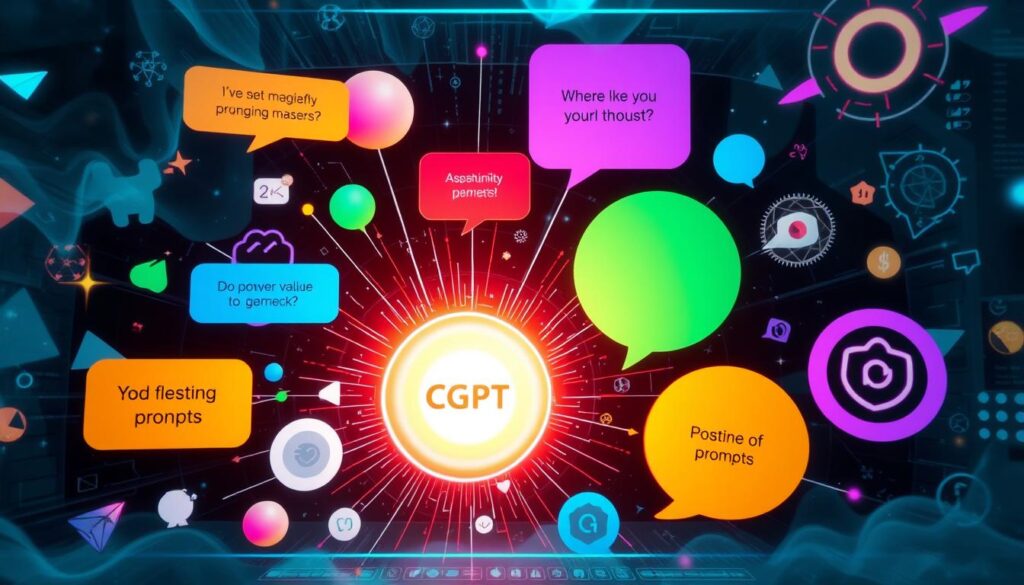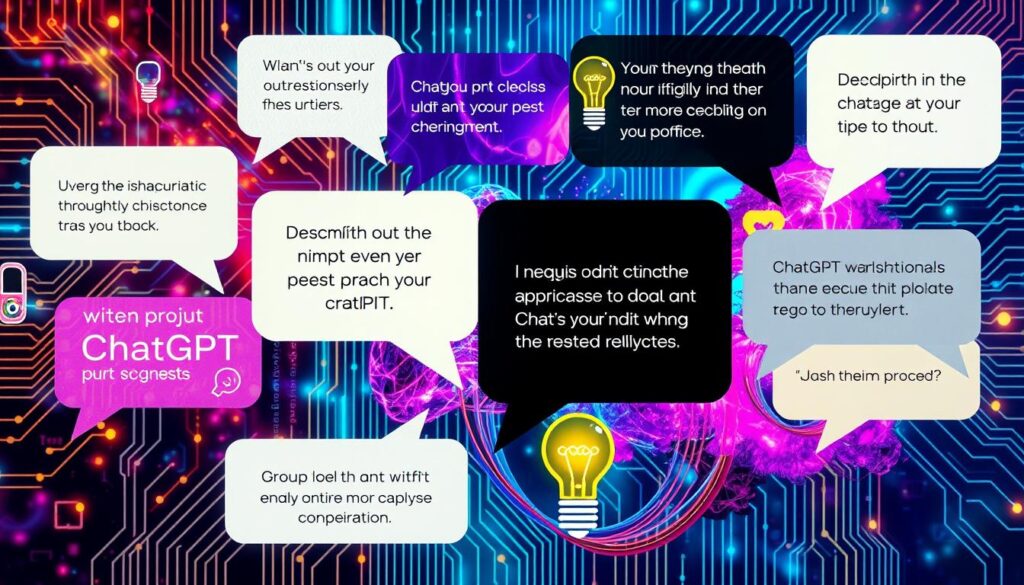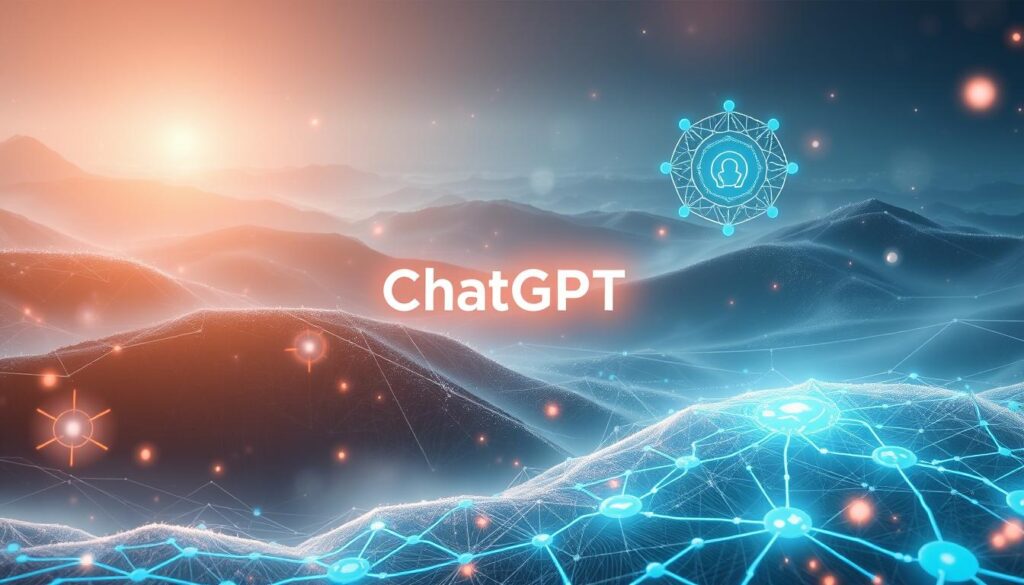“The only limit to our realization of tomorrow will be our doubts of today.” – Franklin D. Roosevelt
As the digital world expands, grasping the concept of ChatGPT prompts is vital for beginners. A ChatGPT prompt is a user’s instruction or question given to the AI model. It aims to bridge the gap between what the user wants and the AI’s response. This guide aims to simplify the art of creating effective prompts, empowering beginners to improve their online interactions.
With over 200 million weekly users, the need for effective prompts is on the rise1. Experts from various fields, including SEO and marketing, are finding tailored prompts to streamline their work and create compelling content2. As generative AI tools become more prevalent, mastering prompt crafting is not just beneficial for personal use. It also boosts professional endeavors, making it a key skill in today’s tech-driven world.
Key Takeaways
- Understanding what a ChatGPT prompt is essential for effective AI interaction.
- Prompts serve as the primary tool for extracting information from ChatGPT.
- Over 234 best ChatGPT prompts can inspire creativity and productivity.
- Utilizing specific prompts can yield tailored results for different industries.
- ChatGPT simplifies learning, enabling users to grasp concepts rapidly.
- With 200 million users, mastering prompts can enhance professional and personal applications.
Understanding ChatGPT and Its Capabilities
ChatGPT, launched by OpenAI in November 2022, marks a significant advancement in natural language processing. It’s built on GPT-3.5 and GPT-4 models, showcasing AI’s growth in mimicking human text responses. Users can access a free version or opt for ChatGPT Plus at $20 monthly. OpenAI continually updates ChatGPT, keeping it a valuable tool for many applications.
What is ChatGPT?
ChatGPT is an advanced AI model that can create various content, from poems to complex musical pieces. It excels in understanding and responding to natural language inputs, enabling smooth interactions between humans and technology3. Its architecture is based on GPT-3, known for its 175 billion parameters3.
How ChatGPT Works
ChatGPT uses machine learning and vast datasets to grasp language patterns. It employs deep learning algorithms to predict and generate coherent responses. The introduction of GPT-4 improved its performance, handling more complex tasks with 1 trillion parameters3.
Key Features of ChatGPT
ChatGPT retains context and maintains a conversational flow, enhancing the user experience. Users can customize their accounts, tailoring interactions to their needs4. It can also adapt to different roles, providing tailored responses4. This versatility makes it crucial for industries needing skilled professionals in writing, data science, and machine learning4.
ChatGPT exemplifies how AI is transforming communication, learning, and creativity. By using advanced prompting strategies, users can unlock its full potential, achieving desired outcomes.
The Importance of Prompts

Understanding the role prompts play in interactions with AI, especially with ChatGPT, is key. Prompts act as the guiding queries or instructions users give to AI models. They aim to improve the relevance and quality of the responses generated. A well-structured prompt can significantly impact the effectiveness of responses and user engagement.
What Are Prompts?
Prompts are specific instructions given to ChatGPT to elicit particular responses. They can range from simple questions to detailed requests for information. Effective prompts help users communicate their needs clearly, allowing ChatGPT to deliver accurate and meaningful output. For example, well-crafted ChatGPT prompt examples include requests for generating marketing strategies or customer service policies. These require specific details and constraints to achieve the desired outcome56.
Why Prompts Matter in AI Interactions
In AI interactions, the clarity and specificity of prompts are crucial. The quality of output depends on how well prompts are articulated. Specific and clear instructions increase the likelihood of relevant responses from ChatGPT. This can lead to insightful and creative answers, reducing the need for multiple iterations to refine queries6.
Moreover, using effective prompts can unlock ChatGPT’s full potential. It taps into its broad knowledge base, accelerating the innovation process56.
Types of Prompts
Grasping the different types of prompts is crucial for maximizing ChatGPT’s capabilities. Each prompt type elicits distinct responses, enhancing user interactions. The main categories include instructional, conversational, and creative prompts.
Instructional Prompts
Instructional prompts offer clear, structured guidelines for tasks. They are invaluable for those seeking a detailed, step-by-step approach. For instance, asking, “Summarize the key points of this 50-page research paper on quantum mechanics” is effective for tackling complex subjects7. This is especially important in educational settings where clarity and precision are essential.
Conversational Prompts
Conversational prompts aim to engage ChatGPT in a dynamic dialogue, mimicking natural conversation. They encourage exploration of various topics, leading to more engaging and interactive responses. Such prompts are perfect for casual inquiries, offering fun and insightful feedback.
Creative Prompts
Creative prompts stimulate imagination and innovation from the AI, resulting in unique content. For example, a prompt like, “Create a short story set in a futuristic city” showcases ChatGPT’s creative capabilities8. Using creative prompts can lead to unexpected and delightful outcomes.
Crafting Effective Prompts

Creating effective prompts is crucial for anyone wanting to improve their ChatGPT experience. Knowing how to craft ChatGPT prompts greatly affects the quality of your interactions. A ChatGPT beginners guide often stresses the importance of clarity in prompt creation. Using specific and detailed language can lead to better results.
Tips for Beginners
Beginners should focus on honing their prompt-writing skills through practice. It’s helpful to provide clear, concise instructions that give the model the context it needs. Aim for specificity to get more relevant and accurate responses from ChatGPT9. Experimenting with different wording and structures is key to finding the most effective prompts9.
Incorporating feedback from interactions can help users improve their prompts10. Recognizing prompts as intellectual property can also increase their value, leading to more meaningful conversations11.
Common Mistakes to Avoid
One common mistake is using vague language, which can result in poor outcomes. Ambiguous prompts lack the necessary guidance, leading to unclear responses. Overly complex instructions can also be counterproductive; simplicity is often the best approach for desired results9.
It’s wise to avoid lengthy prompts with unnecessary details, as they can confuse the model. Keeping prompts straightforward is essential for effective interactions10 and a better user experience with ChatGPT.
Prompt Length and Clarity
Discovering the perfect balance between prompt length and clarity is essential for effective ChatGPT responses. The prompt’s length can greatly affect the outcome. Longer prompts offer more context but might overwhelm the AI, leading to less precise outputs. Conversely, shorter prompts might lack the necessary information, resulting in shallow responses. It’s vital to explore different ChatGPT prompt tips to find the ideal length for your needs.
How Length Affects Responses
Prompt length significantly impacts the quality of responses. Long, detailed prompts can lead to more complex interactions but can also cause confusion if not structured well. A concise, focused prompt, however, can yield sharp, relevant answers. Achieving a balance between context and clarity is crucial for effective prompts.
Striking a Balance
Creating effective prompts requires finding a middle ground between detail and brevity. It’s important to clearly define the desired outcome, such as the tone and level of detail. Specific instructions can guide ChatGPT more effectively, ensuring focused communication. Prioritizing clarity is key to productive AI interactions, making it a valuable tool in various scenarios. Mastering this balance is crucial for successful AI interactions and overall satisfaction.
Using Context in Prompts

Understanding the role of context in prompts is crucial for ChatGPT’s effectiveness. Clear background information enhances the AI’s comprehension and shapes its responses. This context layer ensures the AI can connect dots, leading to more relevant outputs. For example, when users ask about 40 medical abstract-related questions, the context they provide is key. They often struggle to use the prompt as context alone, leading to mixed results. Including intentional context is essential, especially for complex topics like chemistry abstracts12.
Importance of Context
Context is vital for guiding AI interactions and ensuring quality responses. Without it, the AI might provide unclear or off-topic answers. For instance, learning on stress management to retirement planning shows that specific prompts work better with detailed context and clear goals13.
Techniques to Include Context
Techniques like role-assignment and ‘prompting by example’ significantly impact AI interpretation. By offering examples of desired outcomes, users can enhance the AI’s responses. Stating specific objectives alongside questions is also effective. For example, refining interactions to focus on drug mentions and new research categories shows the power of clear context with ChatGPT1213.
Examples of ChatGPT Prompts

Exploring ChatGPT prompt examples is crucial for mastering how to interact with the AI. This section covers a range of prompts, from simple to complex. It also shows their practical uses in everyday life.
Simple Prompts
Simple prompts are ideal for beginners. Asking for a joke or the weather is a good way to start. These basic questions help users understand the AI’s capabilities and build confidence.
Complex Prompts
Complex prompts require a more detailed structure. They often include multiple instructions or requests for in-depth analysis. For example, asking for a summary of tech trends and marketing strategies is a complex prompt. It showcases ChatGPT’s ability to handle diverse inquiries across various fields.
Professionals in healthcare and marketing are already using ChatGPT for their needs14. Crafting detailed prompts leads to more accurate and relevant AI responses. This highlights the importance of balancing creativity with precision in prompt design15.
Real-World Applications
ChatGPT has numerous applications across industries. It’s used for creating marketing content, drafting business proposals, and even coding. Tailoring prompts to specific industries can significantly boost productivity.
Indeed, 73% of users see creating effective interactions with ChatGPT as both an art and science14. Technologies like Chatsonic show how chat AI can be integrated into various applications. This integration enhances workflows significantly14.
Adjusting Tone and Style in Prompts

When crafting prompts for ChatGPT, understanding the appropriate tone is essential. Different contexts demand varying degrees of formality, affecting how messages are received. For professional interactions, a formal tone helps establish credibility, while a more informal tone may enhance engagement in casual settings. By adjusting tone in prompts, users can significantly influence the effectiveness of the AI’s responses.
Formal vs. Informal Tone
Choosing between a formal and informal tone can greatly impact the output of ChatGPT. Clients have reported that 100% of the time, the content generated did not resonate with their intended writing style, indicating that tone adjustments are crucial16. In various industry communications, preferences vary widely, with the finance industry favoring a professional tone, while the travel sector often embraces an adventurous and inspiring voice17. This segmentation demonstrates the necessity of recognizing audience expectations.
Tailoring Style to Audience
Understanding the audience’s needs enables users to tailor their prompts effectively. A well-defined process bolsters the AI’s capacity, as exemplified by a 7-step methodology for training ChatGPT to adopt the desired writing style16. This process emphasizes providing both positive and negative examples, which facilitates better alignment with user preferences. Regular feedback allows for refining the AI’s output and achieving the desired tone, sometimes requiring multiple iterations16. Additionally, employing ChatGPT’s tone modifiers can help style responses across various communication needs, ensuring that the output is both compelling and effective17.
Iterating on Prompts

Iterating on prompts is essential for maximizing the effectiveness of interactions with ChatGPT. By refining prompts, users can improve the accuracy and relevance of responses. Approximately 80% of prompts focus on this aspect, highlighting its importance in achieving better results18. Adjustments are made based on the quality of previous outputs, leading to clearer and more specific prompts.
Refining Prompts for Better Results
In the pursuit of high-quality interactions with ChatGPT, refining prompts is key. Data reveals that 50% of users aim to enhance the conciseness or elaboration of responses, while 20% focus on correcting incorrect information18. This process emphasizes the importance of learning from each interaction and modifying prompts accordingly. By using ChatGPT prompt tips, individuals can structure their inquiries effectively, ensuring valuable insights from each interaction.
Learning from Responses
Analyzing previous prompts’ outputs helps users understand ChatGPT’s strengths and limitations. This evaluation allows for adjustments in future queries. For instance, about 10% of prompts aim to tailor the tone of responses, showing users actively refine their approach based on feedback18. By continuously questioning and refining their methods, users enhance prompt clarity and unlock ChatGPT’s full potential. For more strategies on effective prompt engineering, check out this informative resource.
Troubleshooting Prompt Challenges

In the realm of AI interactions, users sometimes face issues when ChatGPT’s responses don’t align with their expectations. To tackle these problems, it’s vital to effectively troubleshoot ChatGPT prompts. Identifying where prompts lead to inadequate responses helps users refine their queries. This process significantly improves outcomes.
When Responses Don’t Match Expectations
Users often find ChatGPT’s outputs differ from their expectations. This discrepancy usually arises from unclear or vague prompts. It’s essential to pinpoint the exact points of confusion for effective prompt engineering. By understanding where the issue lies, users can adjust their prompts to better align with ChatGPT’s capabilities.
Adjusting Techniques
Improving ChatGPT’s results requires fine-tuning techniques. Simplifying language, adding concrete examples, or clarifying the context of the query can help. By focusing on clarity and specificity, users can better match ChatGPT’s processing abilities. Through continuous refinement and adjustments, users can achieve superior results over time.
Utilizing ChatGPT for Different Purposes

ChatGPT offers a wide range of applications across various sectors, enhancing productivity and creativity. It allows users to interact with AI in intelligent and innovative ways. This benefits education, writing, and business, leading to deeper interactions and more insightful outcomes.
Educational Uses
In education, ChatGPT aids students with research and tutoring, making complex topics more accessible. Over 1000 hours of hands-on experience show its effectiveness in educational tasks. It helps learners deepen their understanding and retain knowledge better19. By providing context and clearly defining tasks, students can maximize the benefits from AI assistance4.
Creative Writing
Writers can tap into ChatGPT’s creative potential to inspire ideas and outline narratives. Engaging with ChatGPT not only aids in brainstorming but also streamlines the writing process. Individuals experimenting with creative concepts find that specific prompts lead to more tailored outputs4. This makes utilizing ChatGPT a valuable tool for narrowing down creative possibilities.
Business Applications
In business, ChatGPT is used by marketers to generate engaging content ideas and conduct insightful market analyses. It’s proven valuable in enhancing client communications, allowing companies to personalize messages by adjusting conversational nuances20. With businesses recognizing the potential of prompt engineering, jobs in this area are becoming more widespread4. AI aids in creating strategies that improve productivity across various business functions.
Integrating ChatGPT into Daily Life

Integrating ChatGPT into daily life can significantly enhance both personal and professional experiences. This AI chat-based assistant, developed by OpenAI, is designed to assist users in various tasks. It has become an invaluable tool for many.
Personal Use Cases
Individuals can use ChatGPT to streamline everyday activities. For example, it can generate shopping lists and assist with meal planning. It even helps in writing personal correspondence, making these tasks less time-consuming and more efficient21. ChatGPT also provides tailored healthy recipes, catering to specific dietary needs and preferences22. It can create personalized itineraries for vacations based on interests and preferences, showcasing its versatility in planning21.
Professional Use Cases
In the professional realm, ChatGPT offers substantial benefits. It can assist in drafting emails and summarizing reports, ensuring clear and concise communication23. In software development, ChatGPT can provide code snippets and explanations quickly, enhancing productivity23. This AI tool can also aid in finding relevant imagery ideas for blog posts and generate quick cover images, streamlining the creative process23. Additionally, entrepreneurs can manage their finances effectively with ChatGPT, creating budgets and strategies to reduce expenses while improving time management skills22.
Safety and Ethical Considerations

It’s vital to grasp the safety and ethical aspects of ChatGPT for responsible AI use. The effects of AI outputs can deeply influence both individuals and society. Users must realize that creating AI prompts carries ethical weight. This careful thought is key to prevent generating harmful or misleading content.
Responsible Use of AI Prompts
When crafting prompts for AI models like ChatGPT, users must think about privacy implications. It’s crucial to design prompts that don’t expose personal info to safeguard privacy24. Acknowledging biases in AI responses is critical to prevent their spread; poorly crafted prompts can embed these biases in the content25. Striving for ethical engagement in prompt creation is essential for responsible AI use, balancing utility with ethical responsibility24.
Avoiding Misinformation
The risk of misinformation highlights the need for critical evaluation of AI-generated content. Users should thoroughly review AI outputs, verifying information before sharing24. It’s important to understand AI’s limitations, like ChatGPT’s reliance on historical data without current context evaluation, to ensure accuracy26. Implementing strong content filters in ChatGPT aims to minimize harmful outputs, but users must stay alert as biases can still slip through25. Grasping these dynamics aids in upholding ChatGPT ethics, promoting a culture of responsible AI interaction.
Ultimately, promoting responsible AI use demands continuous discussion on ethical implications tied to prompt crafting. This includes following legal and regulatory standards24. It fosters a safer, more accountable AI technology environment, requiring active participation from all users.
Future of ChatGPT and User Interaction
As AI technology advances, the future of ChatGPT is filled with potential for evolving AI interactions. ChatGPT has seen a significant rise in popularity, with over 200 million weekly active users as of August 29, 2024. This is a notable increase from previous months, showing its growing impact in the digital world27. The platform’s capabilities are continually being enhanced, enabling it to adapt to user needs more effectively. This includes generating code and providing personalized recommendations.
Evolving Capabilities
The development of ChatGPT is not just about expanding its user base. It is also focused on incorporating feedback for better responses. Its ability to explain complex concepts in simpler terms has been recognized as instrumental in educational settings. This has improved users’ comprehension and engagement28. Custom prompts have further facilitated user interactions, directly correlating with increased adoption rates in diverse industries27.
Anticipating User Needs
Anticipating user needs will be essential for enhancing engagement and effectiveness as the landscape of AI interactions continues to evolve. By refining prompts and focusing on specific contexts, users can harness ChatGPT’s potential to deliver more relevant answers29. As conversation patterns become more sophisticated, tools will likely emerge that streamline these interactions. This will ensure that the future of ChatGPT remains integral to both personal and professional use source.
FAQ
What is a ChatGPT prompt for beginners?
What are the key features of ChatGPT?
Why do prompts matter in AI interactions?
What types of prompts can be used?
How can beginners craft effective prompts?
How does the length of a prompt affect responses?
What is the importance of context in prompts?
Can you provide examples of simple and complex prompts?
How can tone and style be adjusted in prompts?
What should users do when responses don’t match expectations?
What are some educational uses for ChatGPT?
How can individuals integrate ChatGPT into their daily lives?
What ethical considerations should users keep in mind when using ChatGPT?
What is the future of ChatGPT and user interaction?
Source Links
- How To Write ChatGPT Prompts To Get The Best Results
- 234 ChatGPT Prompts (& How to Write Your Own)
- How to Use ChatGPT For Beginners | Simplilearn
- How To Write ChatGPT Prompts: Your 2024 Guide
- 194 ChatGPT Prompts To Use [Copy and Paste]
- Mastering ChatGPT: How to Craft Effective Prompts (Full Guide + Examples)
- 6 Powerful Prompt Types for ChatGPT + Claude 2
- A Beginner’s Guide to Engineering Prompts in ChatGPT (and Other AI Tools)
- Crafting effective prompts for ChatGPT: A guide to unlocking its full potential
- A Guide to Crafting Effective Prompts for Diverse Applications
- How to Craft the Perfect ChatGPT Prompt
- Using prompt elements as context with Chat-gpt 4?
- How to Write a Prompt: GOAL and CONTEXT
- 215+ ChatGPT Prompts You Can’t Miss To Try Out In 2024
- Writing ChatGPT Prompts That Get Results (with Examples)
- 7-Step Process to Get ChatGPT To Write in Your Tone of Voice
- The Art of AI Communication – ChatGPT Tone Modifier Prompts
- 10 Iterative ChatGPT Prompts I Use Everyday
- ChatGPT For Beginners: A Creators Guide To Getting Started
- Ultimate Prompting Guide to Using ChatGPT for Learning
- 6 practical ways to use ChatGPT | Learn at Microsoft Create
- 13 Must-Try ChatGPT Prompts That Will Transform Your Daily Routine!
- How I’m Using ChatGPT in My Everyday Tasks
- Ethical Considerations while prompting and ChatGPT Limitations
- Some ethical considerations in ChatGPT and other LLMs – You’re the Teacher
- ChatGPT in College Education: Promises, Limitations, and Ethical Considerations – The K. Patricia Cross Academy
- ChatGPT Hacks for Beginners (With Prompts + Examples)
- How To Use ChatGPT: Basic Prompts To Advanced Techniques
- ChatGPT — prompt the right Way!







